Managing a Complex Project
VerifiedAdded on 2023/06/11
|12
|3374
|83
AI Summary
This article discusses the Concorde project, its partnership concept, characteristics, general expectations, outcomes, and comparison of expected and real outcomes. It also covers the Cynefin model and effective knowledge management strategies. Course details are not mentioned.
Contribute Materials
Your contribution can guide someone’s learning journey. Share your
documents today.
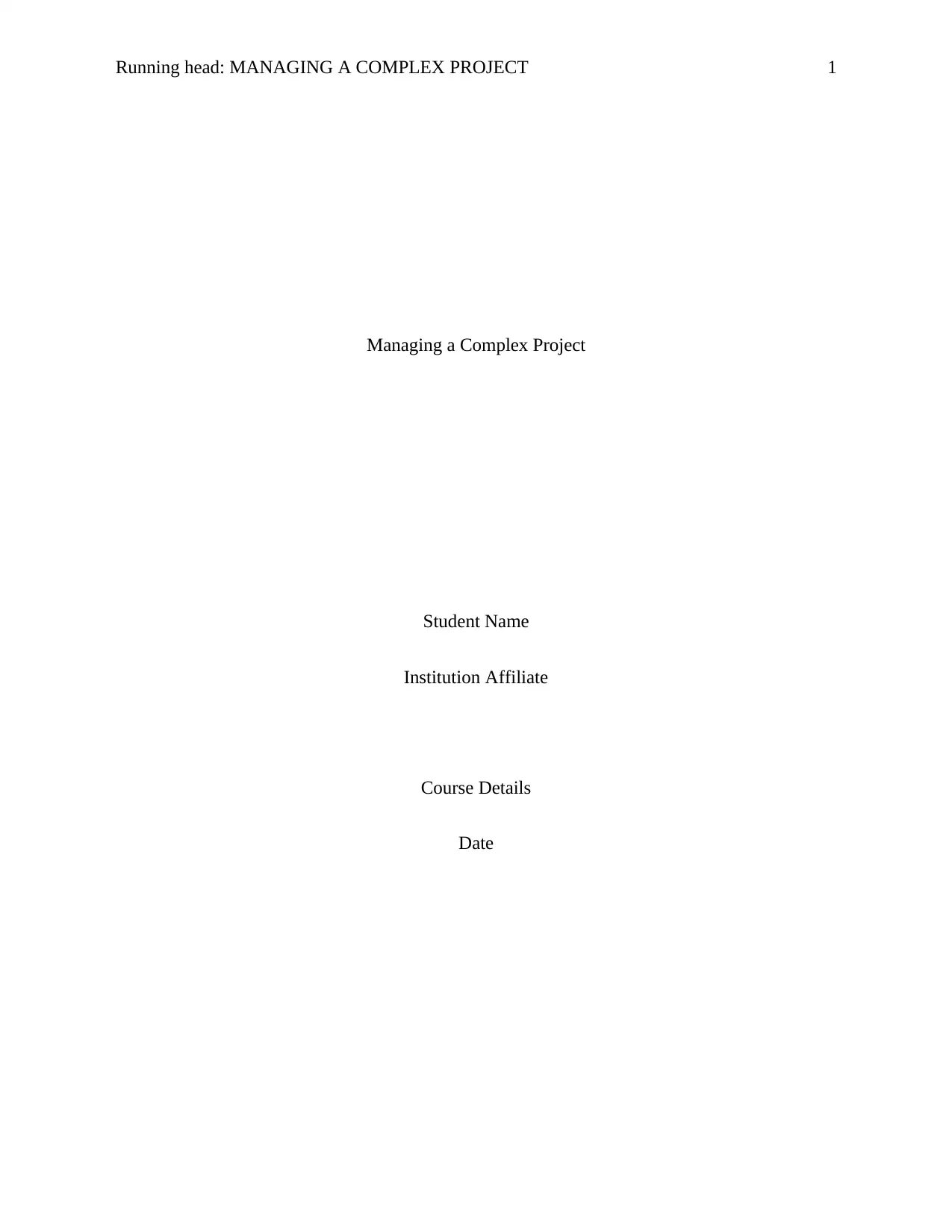
Running head: MANAGING A COMPLEX PROJECT 1
Managing a Complex Project
Student Name
Institution Affiliate
Course Details
Date
Managing a Complex Project
Student Name
Institution Affiliate
Course Details
Date
Secure Best Marks with AI Grader
Need help grading? Try our AI Grader for instant feedback on your assignments.
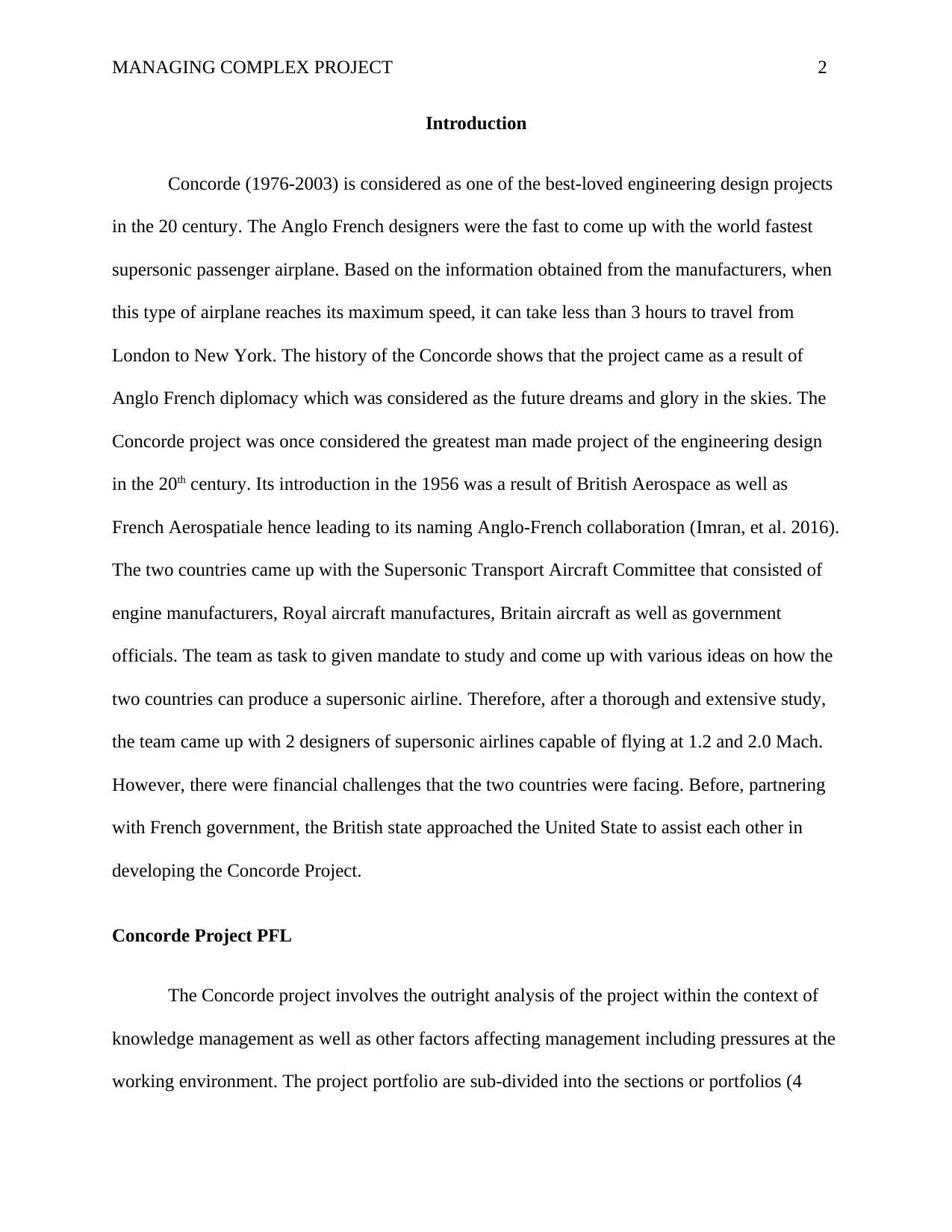
MANAGING COMPLEX PROJECT 2
Introduction
Concorde (1976-2003) is considered as one of the best-loved engineering design projects
in the 20 century. The Anglo French designers were the fast to come up with the world fastest
supersonic passenger airplane. Based on the information obtained from the manufacturers, when
this type of airplane reaches its maximum speed, it can take less than 3 hours to travel from
London to New York. The history of the Concorde shows that the project came as a result of
Anglo French diplomacy which was considered as the future dreams and glory in the skies. The
Concorde project was once considered the greatest man made project of the engineering design
in the 20th century. Its introduction in the 1956 was a result of British Aerospace as well as
French Aerospatiale hence leading to its naming Anglo-French collaboration (Imran, et al. 2016).
The two countries came up with the Supersonic Transport Aircraft Committee that consisted of
engine manufacturers, Royal aircraft manufactures, Britain aircraft as well as government
officials. The team as task to given mandate to study and come up with various ideas on how the
two countries can produce a supersonic airline. Therefore, after a thorough and extensive study,
the team came up with 2 designers of supersonic airlines capable of flying at 1.2 and 2.0 Mach.
However, there were financial challenges that the two countries were facing. Before, partnering
with French government, the British state approached the United State to assist each other in
developing the Concorde Project.
Concorde Project PFL
The Concorde project involves the outright analysis of the project within the context of
knowledge management as well as other factors affecting management including pressures at the
working environment. The project portfolio are sub-divided into the sections or portfolios (4
Introduction
Concorde (1976-2003) is considered as one of the best-loved engineering design projects
in the 20 century. The Anglo French designers were the fast to come up with the world fastest
supersonic passenger airplane. Based on the information obtained from the manufacturers, when
this type of airplane reaches its maximum speed, it can take less than 3 hours to travel from
London to New York. The history of the Concorde shows that the project came as a result of
Anglo French diplomacy which was considered as the future dreams and glory in the skies. The
Concorde project was once considered the greatest man made project of the engineering design
in the 20th century. Its introduction in the 1956 was a result of British Aerospace as well as
French Aerospatiale hence leading to its naming Anglo-French collaboration (Imran, et al. 2016).
The two countries came up with the Supersonic Transport Aircraft Committee that consisted of
engine manufacturers, Royal aircraft manufactures, Britain aircraft as well as government
officials. The team as task to given mandate to study and come up with various ideas on how the
two countries can produce a supersonic airline. Therefore, after a thorough and extensive study,
the team came up with 2 designers of supersonic airlines capable of flying at 1.2 and 2.0 Mach.
However, there were financial challenges that the two countries were facing. Before, partnering
with French government, the British state approached the United State to assist each other in
developing the Concorde Project.
Concorde Project PFL
The Concorde project involves the outright analysis of the project within the context of
knowledge management as well as other factors affecting management including pressures at the
working environment. The project portfolio are sub-divided into the sections or portfolios (4
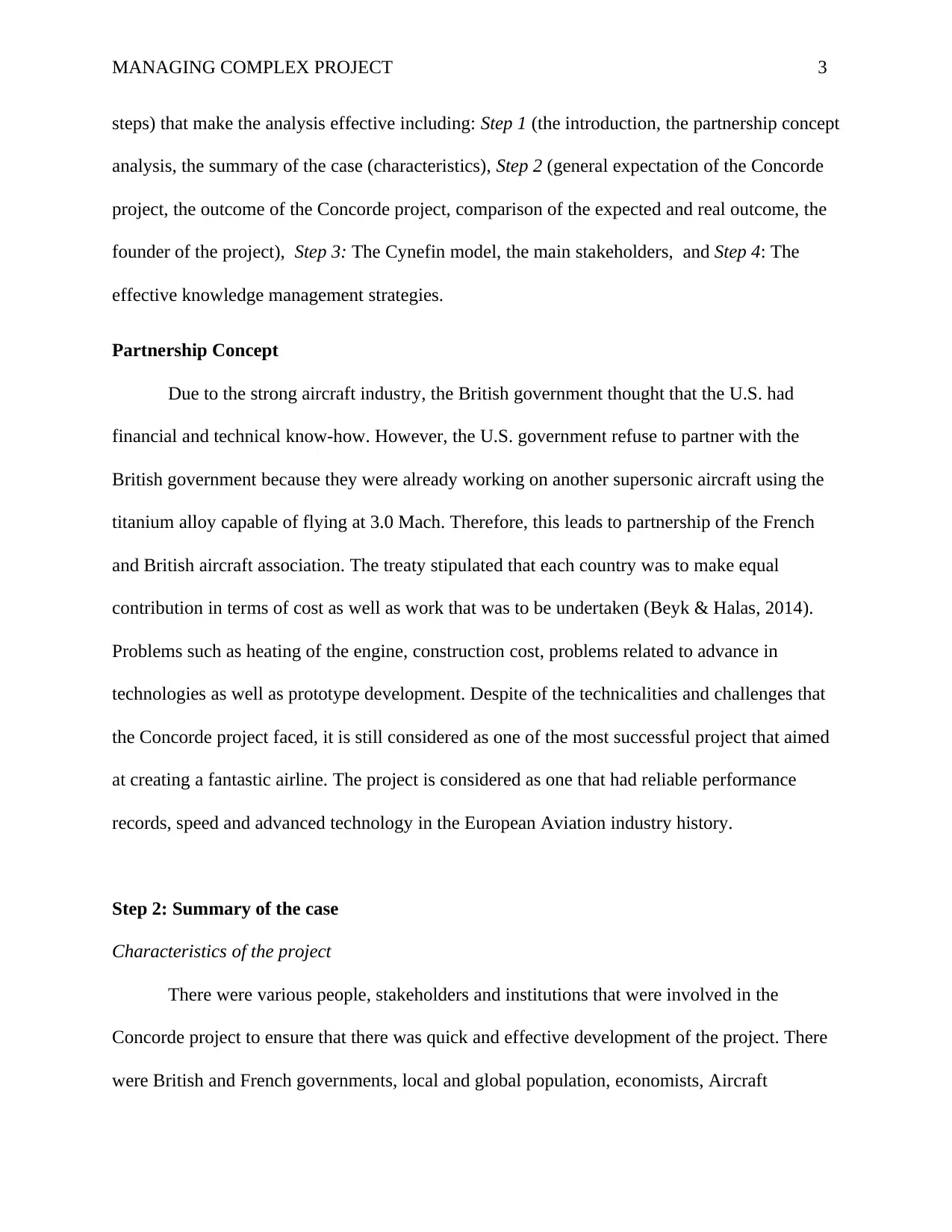
MANAGING COMPLEX PROJECT 3
steps) that make the analysis effective including: Step 1 (the introduction, the partnership concept
analysis, the summary of the case (characteristics), Step 2 (general expectation of the Concorde
project, the outcome of the Concorde project, comparison of the expected and real outcome, the
founder of the project), Step 3: The Cynefin model, the main stakeholders, and Step 4: The
effective knowledge management strategies.
Partnership Concept
Due to the strong aircraft industry, the British government thought that the U.S. had
financial and technical know-how. However, the U.S. government refuse to partner with the
British government because they were already working on another supersonic aircraft using the
titanium alloy capable of flying at 3.0 Mach. Therefore, this leads to partnership of the French
and British aircraft association. The treaty stipulated that each country was to make equal
contribution in terms of cost as well as work that was to be undertaken (Beyk & Halas, 2014).
Problems such as heating of the engine, construction cost, problems related to advance in
technologies as well as prototype development. Despite of the technicalities and challenges that
the Concorde project faced, it is still considered as one of the most successful project that aimed
at creating a fantastic airline. The project is considered as one that had reliable performance
records, speed and advanced technology in the European Aviation industry history.
Step 2: Summary of the case
Characteristics of the project
There were various people, stakeholders and institutions that were involved in the
Concorde project to ensure that there was quick and effective development of the project. There
were British and French governments, local and global population, economists, Aircraft
steps) that make the analysis effective including: Step 1 (the introduction, the partnership concept
analysis, the summary of the case (characteristics), Step 2 (general expectation of the Concorde
project, the outcome of the Concorde project, comparison of the expected and real outcome, the
founder of the project), Step 3: The Cynefin model, the main stakeholders, and Step 4: The
effective knowledge management strategies.
Partnership Concept
Due to the strong aircraft industry, the British government thought that the U.S. had
financial and technical know-how. However, the U.S. government refuse to partner with the
British government because they were already working on another supersonic aircraft using the
titanium alloy capable of flying at 3.0 Mach. Therefore, this leads to partnership of the French
and British aircraft association. The treaty stipulated that each country was to make equal
contribution in terms of cost as well as work that was to be undertaken (Beyk & Halas, 2014).
Problems such as heating of the engine, construction cost, problems related to advance in
technologies as well as prototype development. Despite of the technicalities and challenges that
the Concorde project faced, it is still considered as one of the most successful project that aimed
at creating a fantastic airline. The project is considered as one that had reliable performance
records, speed and advanced technology in the European Aviation industry history.
Step 2: Summary of the case
Characteristics of the project
There were various people, stakeholders and institutions that were involved in the
Concorde project to ensure that there was quick and effective development of the project. There
were British and French governments, local and global population, economists, Aircraft
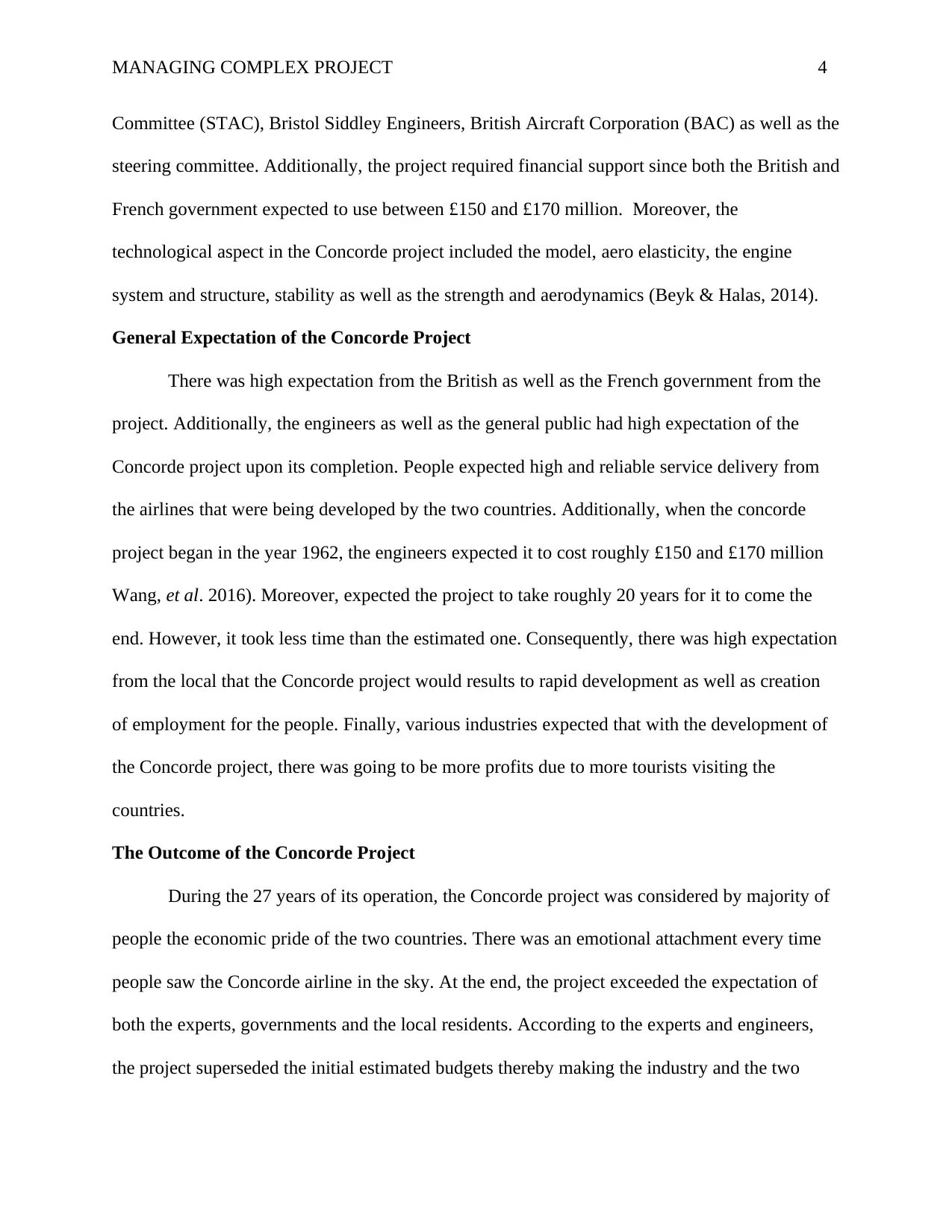
MANAGING COMPLEX PROJECT 4
Committee (STAC), Bristol Siddley Engineers, British Aircraft Corporation (BAC) as well as the
steering committee. Additionally, the project required financial support since both the British and
French government expected to use between £150 and £170 million. Moreover, the
technological aspect in the Concorde project included the model, aero elasticity, the engine
system and structure, stability as well as the strength and aerodynamics (Beyk & Halas, 2014).
General Expectation of the Concorde Project
There was high expectation from the British as well as the French government from the
project. Additionally, the engineers as well as the general public had high expectation of the
Concorde project upon its completion. People expected high and reliable service delivery from
the airlines that were being developed by the two countries. Additionally, when the concorde
project began in the year 1962, the engineers expected it to cost roughly £150 and £170 million
Wang, et al. 2016). Moreover, expected the project to take roughly 20 years for it to come the
end. However, it took less time than the estimated one. Consequently, there was high expectation
from the local that the Concorde project would results to rapid development as well as creation
of employment for the people. Finally, various industries expected that with the development of
the Concorde project, there was going to be more profits due to more tourists visiting the
countries.
The Outcome of the Concorde Project
During the 27 years of its operation, the Concorde project was considered by majority of
people the economic pride of the two countries. There was an emotional attachment every time
people saw the Concorde airline in the sky. At the end, the project exceeded the expectation of
both the experts, governments and the local residents. According to the experts and engineers,
the project superseded the initial estimated budgets thereby making the industry and the two
Committee (STAC), Bristol Siddley Engineers, British Aircraft Corporation (BAC) as well as the
steering committee. Additionally, the project required financial support since both the British and
French government expected to use between £150 and £170 million. Moreover, the
technological aspect in the Concorde project included the model, aero elasticity, the engine
system and structure, stability as well as the strength and aerodynamics (Beyk & Halas, 2014).
General Expectation of the Concorde Project
There was high expectation from the British as well as the French government from the
project. Additionally, the engineers as well as the general public had high expectation of the
Concorde project upon its completion. People expected high and reliable service delivery from
the airlines that were being developed by the two countries. Additionally, when the concorde
project began in the year 1962, the engineers expected it to cost roughly £150 and £170 million
Wang, et al. 2016). Moreover, expected the project to take roughly 20 years for it to come the
end. However, it took less time than the estimated one. Consequently, there was high expectation
from the local that the Concorde project would results to rapid development as well as creation
of employment for the people. Finally, various industries expected that with the development of
the Concorde project, there was going to be more profits due to more tourists visiting the
countries.
The Outcome of the Concorde Project
During the 27 years of its operation, the Concorde project was considered by majority of
people the economic pride of the two countries. There was an emotional attachment every time
people saw the Concorde airline in the sky. At the end, the project exceeded the expectation of
both the experts, governments and the local residents. According to the experts and engineers,
the project superseded the initial estimated budgets thereby making the industry and the two
Secure Best Marks with AI Grader
Need help grading? Try our AI Grader for instant feedback on your assignments.
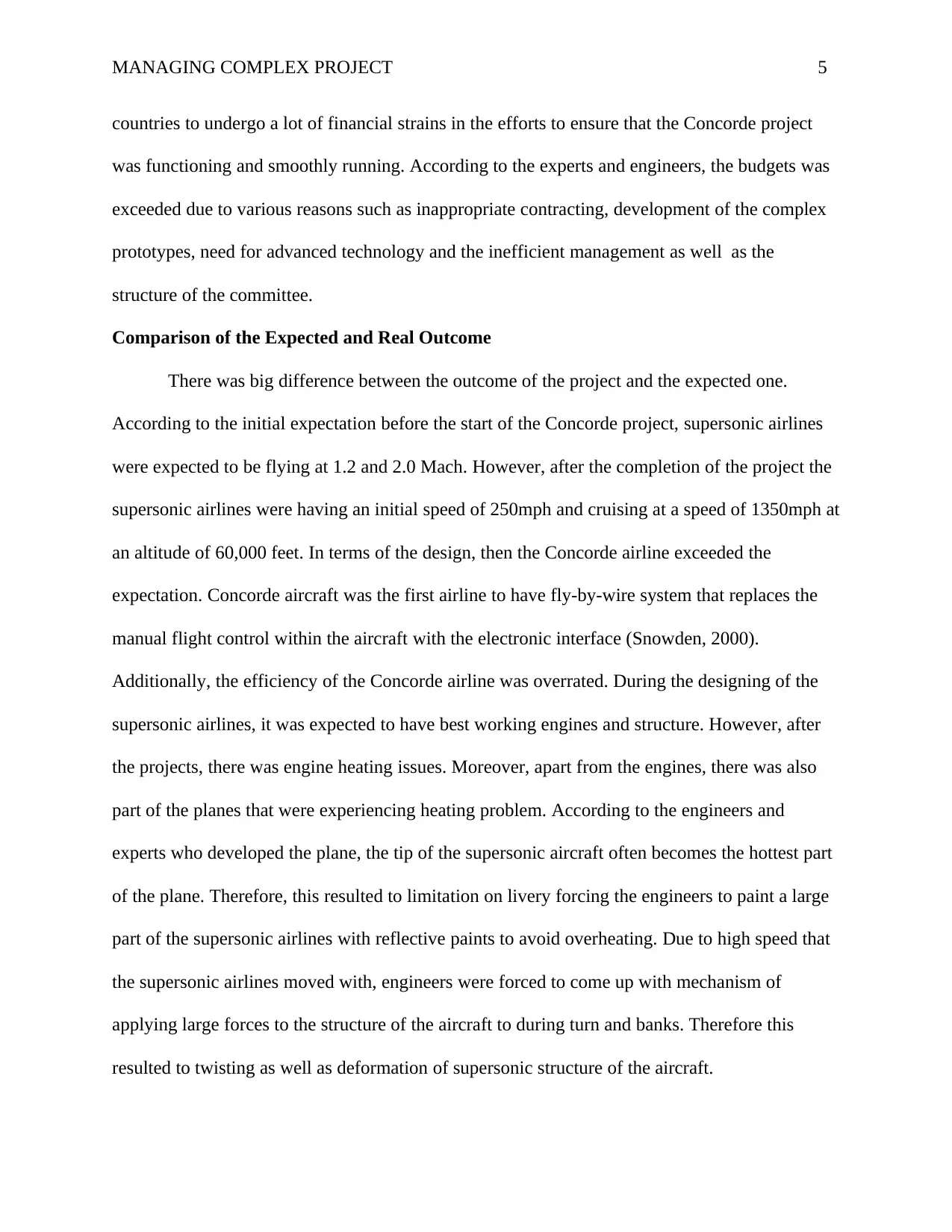
MANAGING COMPLEX PROJECT 5
countries to undergo a lot of financial strains in the efforts to ensure that the Concorde project
was functioning and smoothly running. According to the experts and engineers, the budgets was
exceeded due to various reasons such as inappropriate contracting, development of the complex
prototypes, need for advanced technology and the inefficient management as well as the
structure of the committee.
Comparison of the Expected and Real Outcome
There was big difference between the outcome of the project and the expected one.
According to the initial expectation before the start of the Concorde project, supersonic airlines
were expected to be flying at 1.2 and 2.0 Mach. However, after the completion of the project the
supersonic airlines were having an initial speed of 250mph and cruising at a speed of 1350mph at
an altitude of 60,000 feet. In terms of the design, then the Concorde airline exceeded the
expectation. Concorde aircraft was the first airline to have fly-by-wire system that replaces the
manual flight control within the aircraft with the electronic interface (Snowden, 2000).
Additionally, the efficiency of the Concorde airline was overrated. During the designing of the
supersonic airlines, it was expected to have best working engines and structure. However, after
the projects, there was engine heating issues. Moreover, apart from the engines, there was also
part of the planes that were experiencing heating problem. According to the engineers and
experts who developed the plane, the tip of the supersonic aircraft often becomes the hottest part
of the plane. Therefore, this resulted to limitation on livery forcing the engineers to paint a large
part of the supersonic airlines with reflective paints to avoid overheating. Due to high speed that
the supersonic airlines moved with, engineers were forced to come up with mechanism of
applying large forces to the structure of the aircraft to during turn and banks. Therefore this
resulted to twisting as well as deformation of supersonic structure of the aircraft.
countries to undergo a lot of financial strains in the efforts to ensure that the Concorde project
was functioning and smoothly running. According to the experts and engineers, the budgets was
exceeded due to various reasons such as inappropriate contracting, development of the complex
prototypes, need for advanced technology and the inefficient management as well as the
structure of the committee.
Comparison of the Expected and Real Outcome
There was big difference between the outcome of the project and the expected one.
According to the initial expectation before the start of the Concorde project, supersonic airlines
were expected to be flying at 1.2 and 2.0 Mach. However, after the completion of the project the
supersonic airlines were having an initial speed of 250mph and cruising at a speed of 1350mph at
an altitude of 60,000 feet. In terms of the design, then the Concorde airline exceeded the
expectation. Concorde aircraft was the first airline to have fly-by-wire system that replaces the
manual flight control within the aircraft with the electronic interface (Snowden, 2000).
Additionally, the efficiency of the Concorde airline was overrated. During the designing of the
supersonic airlines, it was expected to have best working engines and structure. However, after
the projects, there was engine heating issues. Moreover, apart from the engines, there was also
part of the planes that were experiencing heating problem. According to the engineers and
experts who developed the plane, the tip of the supersonic aircraft often becomes the hottest part
of the plane. Therefore, this resulted to limitation on livery forcing the engineers to paint a large
part of the supersonic airlines with reflective paints to avoid overheating. Due to high speed that
the supersonic airlines moved with, engineers were forced to come up with mechanism of
applying large forces to the structure of the aircraft to during turn and banks. Therefore this
resulted to twisting as well as deformation of supersonic structure of the aircraft.
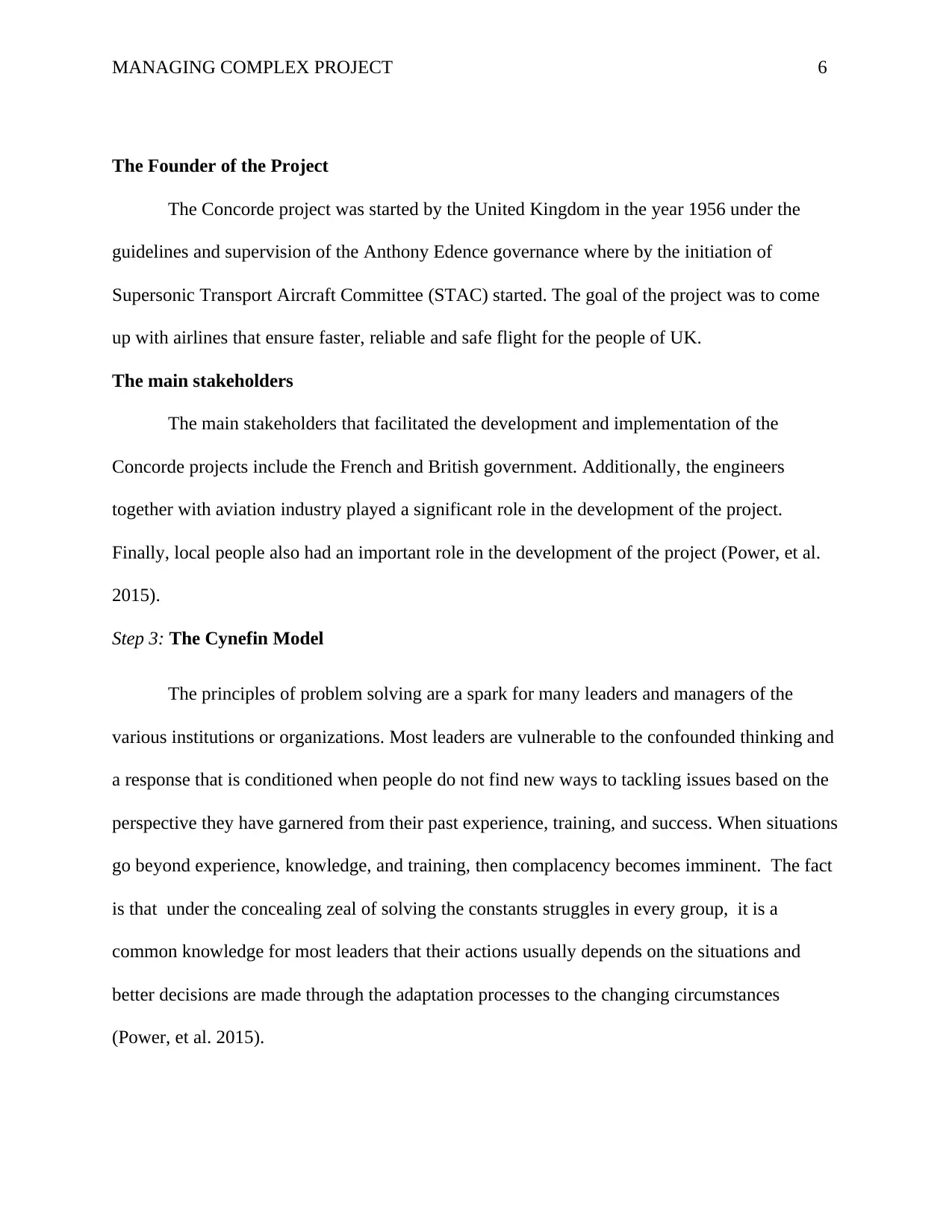
MANAGING COMPLEX PROJECT 6
The Founder of the Project
The Concorde project was started by the United Kingdom in the year 1956 under the
guidelines and supervision of the Anthony Edence governance where by the initiation of
Supersonic Transport Aircraft Committee (STAC) started. The goal of the project was to come
up with airlines that ensure faster, reliable and safe flight for the people of UK.
The main stakeholders
The main stakeholders that facilitated the development and implementation of the
Concorde projects include the French and British government. Additionally, the engineers
together with aviation industry played a significant role in the development of the project.
Finally, local people also had an important role in the development of the project (Power, et al.
2015).
Step 3: The Cynefin Model
The principles of problem solving are a spark for many leaders and managers of the
various institutions or organizations. Most leaders are vulnerable to the confounded thinking and
a response that is conditioned when people do not find new ways to tackling issues based on the
perspective they have garnered from their past experience, training, and success. When situations
go beyond experience, knowledge, and training, then complacency becomes imminent. The fact
is that under the concealing zeal of solving the constants struggles in every group, it is a
common knowledge for most leaders that their actions usually depends on the situations and
better decisions are made through the adaptation processes to the changing circumstances
(Power, et al. 2015).
The Founder of the Project
The Concorde project was started by the United Kingdom in the year 1956 under the
guidelines and supervision of the Anthony Edence governance where by the initiation of
Supersonic Transport Aircraft Committee (STAC) started. The goal of the project was to come
up with airlines that ensure faster, reliable and safe flight for the people of UK.
The main stakeholders
The main stakeholders that facilitated the development and implementation of the
Concorde projects include the French and British government. Additionally, the engineers
together with aviation industry played a significant role in the development of the project.
Finally, local people also had an important role in the development of the project (Power, et al.
2015).
Step 3: The Cynefin Model
The principles of problem solving are a spark for many leaders and managers of the
various institutions or organizations. Most leaders are vulnerable to the confounded thinking and
a response that is conditioned when people do not find new ways to tackling issues based on the
perspective they have garnered from their past experience, training, and success. When situations
go beyond experience, knowledge, and training, then complacency becomes imminent. The fact
is that under the concealing zeal of solving the constants struggles in every group, it is a
common knowledge for most leaders that their actions usually depends on the situations and
better decisions are made through the adaptation processes to the changing circumstances
(Power, et al. 2015).
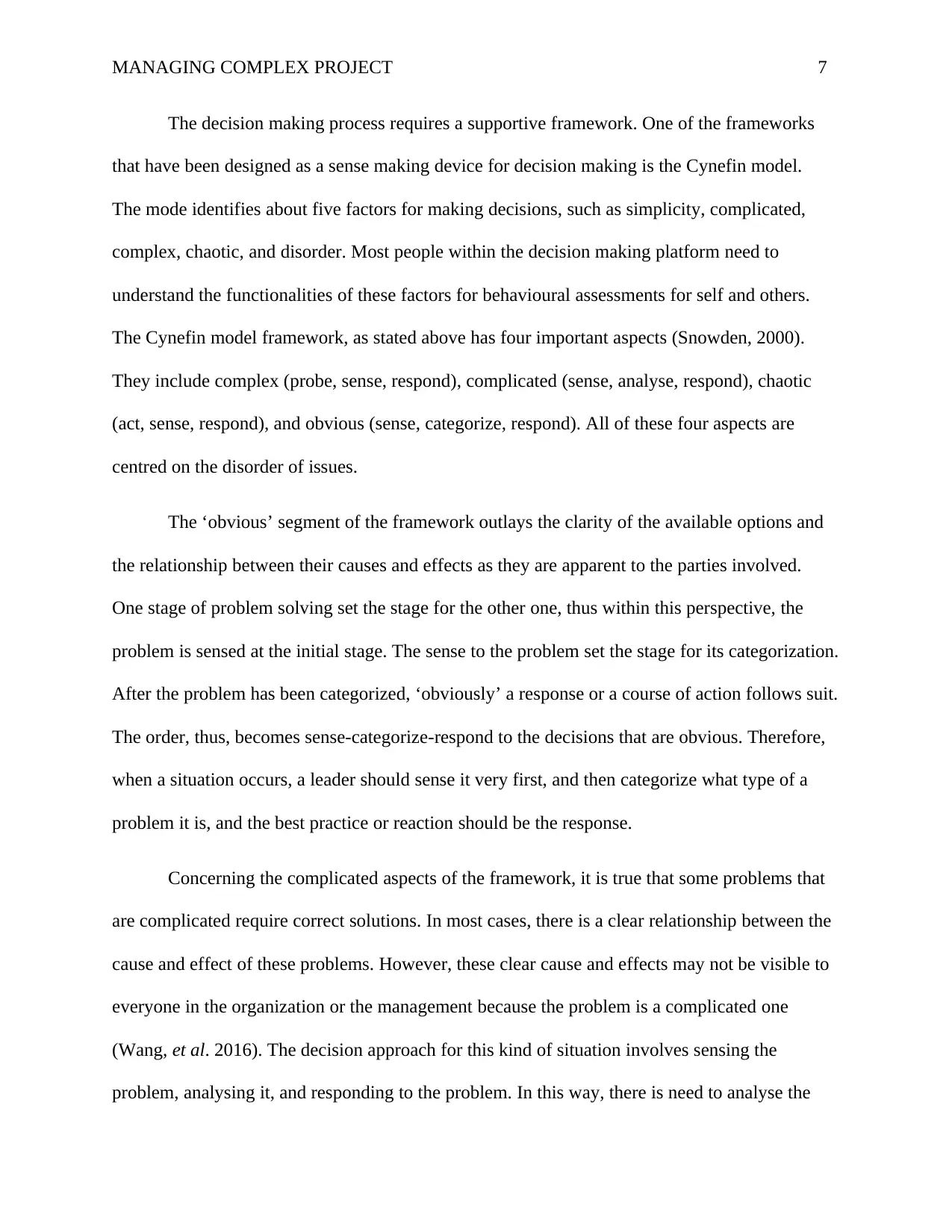
MANAGING COMPLEX PROJECT 7
The decision making process requires a supportive framework. One of the frameworks
that have been designed as a sense making device for decision making is the Cynefin model.
The mode identifies about five factors for making decisions, such as simplicity, complicated,
complex, chaotic, and disorder. Most people within the decision making platform need to
understand the functionalities of these factors for behavioural assessments for self and others.
The Cynefin model framework, as stated above has four important aspects (Snowden, 2000).
They include complex (probe, sense, respond), complicated (sense, analyse, respond), chaotic
(act, sense, respond), and obvious (sense, categorize, respond). All of these four aspects are
centred on the disorder of issues.
The ‘obvious’ segment of the framework outlays the clarity of the available options and
the relationship between their causes and effects as they are apparent to the parties involved.
One stage of problem solving set the stage for the other one, thus within this perspective, the
problem is sensed at the initial stage. The sense to the problem set the stage for its categorization.
After the problem has been categorized, ‘obviously’ a response or a course of action follows suit.
The order, thus, becomes sense-categorize-respond to the decisions that are obvious. Therefore,
when a situation occurs, a leader should sense it very first, and then categorize what type of a
problem it is, and the best practice or reaction should be the response.
Concerning the complicated aspects of the framework, it is true that some problems that
are complicated require correct solutions. In most cases, there is a clear relationship between the
cause and effect of these problems. However, these clear cause and effects may not be visible to
everyone in the organization or the management because the problem is a complicated one
(Wang, et al. 2016). The decision approach for this kind of situation involves sensing the
problem, analysing it, and responding to the problem. In this way, there is need to analyse the
The decision making process requires a supportive framework. One of the frameworks
that have been designed as a sense making device for decision making is the Cynefin model.
The mode identifies about five factors for making decisions, such as simplicity, complicated,
complex, chaotic, and disorder. Most people within the decision making platform need to
understand the functionalities of these factors for behavioural assessments for self and others.
The Cynefin model framework, as stated above has four important aspects (Snowden, 2000).
They include complex (probe, sense, respond), complicated (sense, analyse, respond), chaotic
(act, sense, respond), and obvious (sense, categorize, respond). All of these four aspects are
centred on the disorder of issues.
The ‘obvious’ segment of the framework outlays the clarity of the available options and
the relationship between their causes and effects as they are apparent to the parties involved.
One stage of problem solving set the stage for the other one, thus within this perspective, the
problem is sensed at the initial stage. The sense to the problem set the stage for its categorization.
After the problem has been categorized, ‘obviously’ a response or a course of action follows suit.
The order, thus, becomes sense-categorize-respond to the decisions that are obvious. Therefore,
when a situation occurs, a leader should sense it very first, and then categorize what type of a
problem it is, and the best practice or reaction should be the response.
Concerning the complicated aspects of the framework, it is true that some problems that
are complicated require correct solutions. In most cases, there is a clear relationship between the
cause and effect of these problems. However, these clear cause and effects may not be visible to
everyone in the organization or the management because the problem is a complicated one
(Wang, et al. 2016). The decision approach for this kind of situation involves sensing the
problem, analysing it, and responding to the problem. In this way, there is need to analyse the
Paraphrase This Document
Need a fresh take? Get an instant paraphrase of this document with our AI Paraphraser
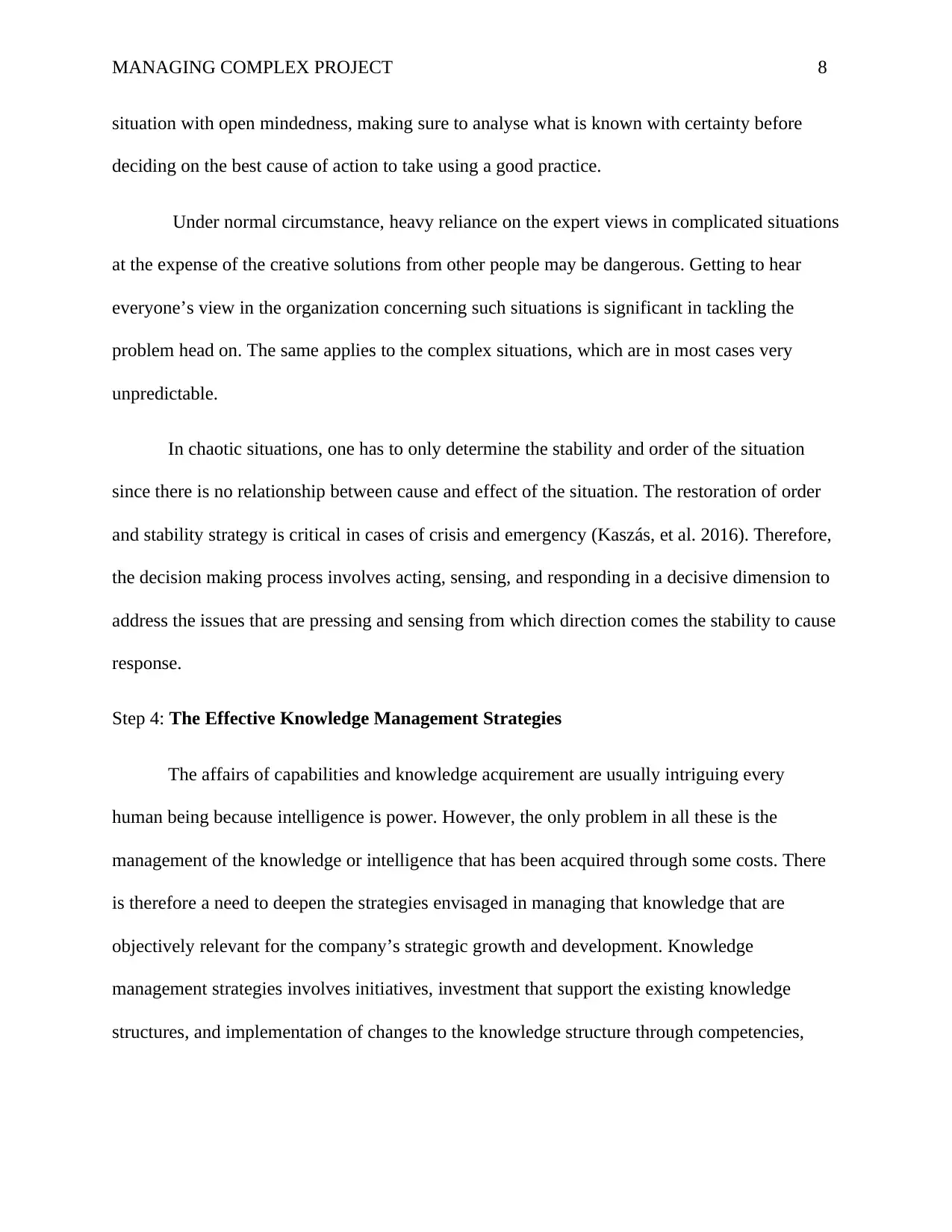
MANAGING COMPLEX PROJECT 8
situation with open mindedness, making sure to analyse what is known with certainty before
deciding on the best cause of action to take using a good practice.
Under normal circumstance, heavy reliance on the expert views in complicated situations
at the expense of the creative solutions from other people may be dangerous. Getting to hear
everyone’s view in the organization concerning such situations is significant in tackling the
problem head on. The same applies to the complex situations, which are in most cases very
unpredictable.
In chaotic situations, one has to only determine the stability and order of the situation
since there is no relationship between cause and effect of the situation. The restoration of order
and stability strategy is critical in cases of crisis and emergency (Kaszás, et al. 2016). Therefore,
the decision making process involves acting, sensing, and responding in a decisive dimension to
address the issues that are pressing and sensing from which direction comes the stability to cause
response.
Step 4: The Effective Knowledge Management Strategies
The affairs of capabilities and knowledge acquirement are usually intriguing every
human being because intelligence is power. However, the only problem in all these is the
management of the knowledge or intelligence that has been acquired through some costs. There
is therefore a need to deepen the strategies envisaged in managing that knowledge that are
objectively relevant for the company’s strategic growth and development. Knowledge
management strategies involves initiatives, investment that support the existing knowledge
structures, and implementation of changes to the knowledge structure through competencies,
situation with open mindedness, making sure to analyse what is known with certainty before
deciding on the best cause of action to take using a good practice.
Under normal circumstance, heavy reliance on the expert views in complicated situations
at the expense of the creative solutions from other people may be dangerous. Getting to hear
everyone’s view in the organization concerning such situations is significant in tackling the
problem head on. The same applies to the complex situations, which are in most cases very
unpredictable.
In chaotic situations, one has to only determine the stability and order of the situation
since there is no relationship between cause and effect of the situation. The restoration of order
and stability strategy is critical in cases of crisis and emergency (Kaszás, et al. 2016). Therefore,
the decision making process involves acting, sensing, and responding in a decisive dimension to
address the issues that are pressing and sensing from which direction comes the stability to cause
response.
Step 4: The Effective Knowledge Management Strategies
The affairs of capabilities and knowledge acquirement are usually intriguing every
human being because intelligence is power. However, the only problem in all these is the
management of the knowledge or intelligence that has been acquired through some costs. There
is therefore a need to deepen the strategies envisaged in managing that knowledge that are
objectively relevant for the company’s strategic growth and development. Knowledge
management strategies involves initiatives, investment that support the existing knowledge
structures, and implementation of changes to the knowledge structure through competencies,
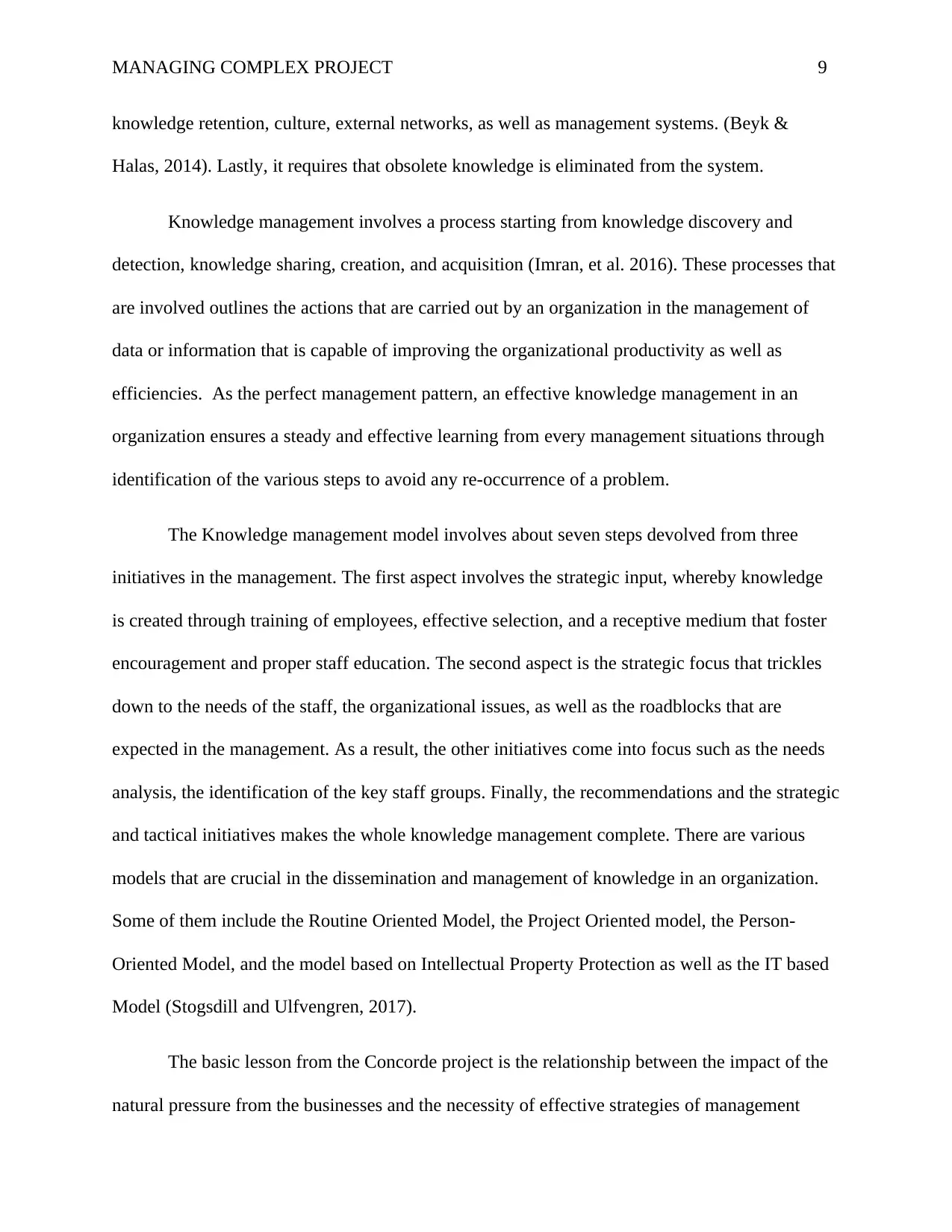
MANAGING COMPLEX PROJECT 9
knowledge retention, culture, external networks, as well as management systems. (Beyk &
Halas, 2014). Lastly, it requires that obsolete knowledge is eliminated from the system.
Knowledge management involves a process starting from knowledge discovery and
detection, knowledge sharing, creation, and acquisition (Imran, et al. 2016). These processes that
are involved outlines the actions that are carried out by an organization in the management of
data or information that is capable of improving the organizational productivity as well as
efficiencies. As the perfect management pattern, an effective knowledge management in an
organization ensures a steady and effective learning from every management situations through
identification of the various steps to avoid any re-occurrence of a problem.
The Knowledge management model involves about seven steps devolved from three
initiatives in the management. The first aspect involves the strategic input, whereby knowledge
is created through training of employees, effective selection, and a receptive medium that foster
encouragement and proper staff education. The second aspect is the strategic focus that trickles
down to the needs of the staff, the organizational issues, as well as the roadblocks that are
expected in the management. As a result, the other initiatives come into focus such as the needs
analysis, the identification of the key staff groups. Finally, the recommendations and the strategic
and tactical initiatives makes the whole knowledge management complete. There are various
models that are crucial in the dissemination and management of knowledge in an organization.
Some of them include the Routine Oriented Model, the Project Oriented model, the Person-
Oriented Model, and the model based on Intellectual Property Protection as well as the IT based
Model (Stogsdill and Ulfvengren, 2017).
The basic lesson from the Concorde project is the relationship between the impact of the
natural pressure from the businesses and the necessity of effective strategies of management
knowledge retention, culture, external networks, as well as management systems. (Beyk &
Halas, 2014). Lastly, it requires that obsolete knowledge is eliminated from the system.
Knowledge management involves a process starting from knowledge discovery and
detection, knowledge sharing, creation, and acquisition (Imran, et al. 2016). These processes that
are involved outlines the actions that are carried out by an organization in the management of
data or information that is capable of improving the organizational productivity as well as
efficiencies. As the perfect management pattern, an effective knowledge management in an
organization ensures a steady and effective learning from every management situations through
identification of the various steps to avoid any re-occurrence of a problem.
The Knowledge management model involves about seven steps devolved from three
initiatives in the management. The first aspect involves the strategic input, whereby knowledge
is created through training of employees, effective selection, and a receptive medium that foster
encouragement and proper staff education. The second aspect is the strategic focus that trickles
down to the needs of the staff, the organizational issues, as well as the roadblocks that are
expected in the management. As a result, the other initiatives come into focus such as the needs
analysis, the identification of the key staff groups. Finally, the recommendations and the strategic
and tactical initiatives makes the whole knowledge management complete. There are various
models that are crucial in the dissemination and management of knowledge in an organization.
Some of them include the Routine Oriented Model, the Project Oriented model, the Person-
Oriented Model, and the model based on Intellectual Property Protection as well as the IT based
Model (Stogsdill and Ulfvengren, 2017).
The basic lesson from the Concorde project is the relationship between the impact of the
natural pressure from the businesses and the necessity of effective strategies of management
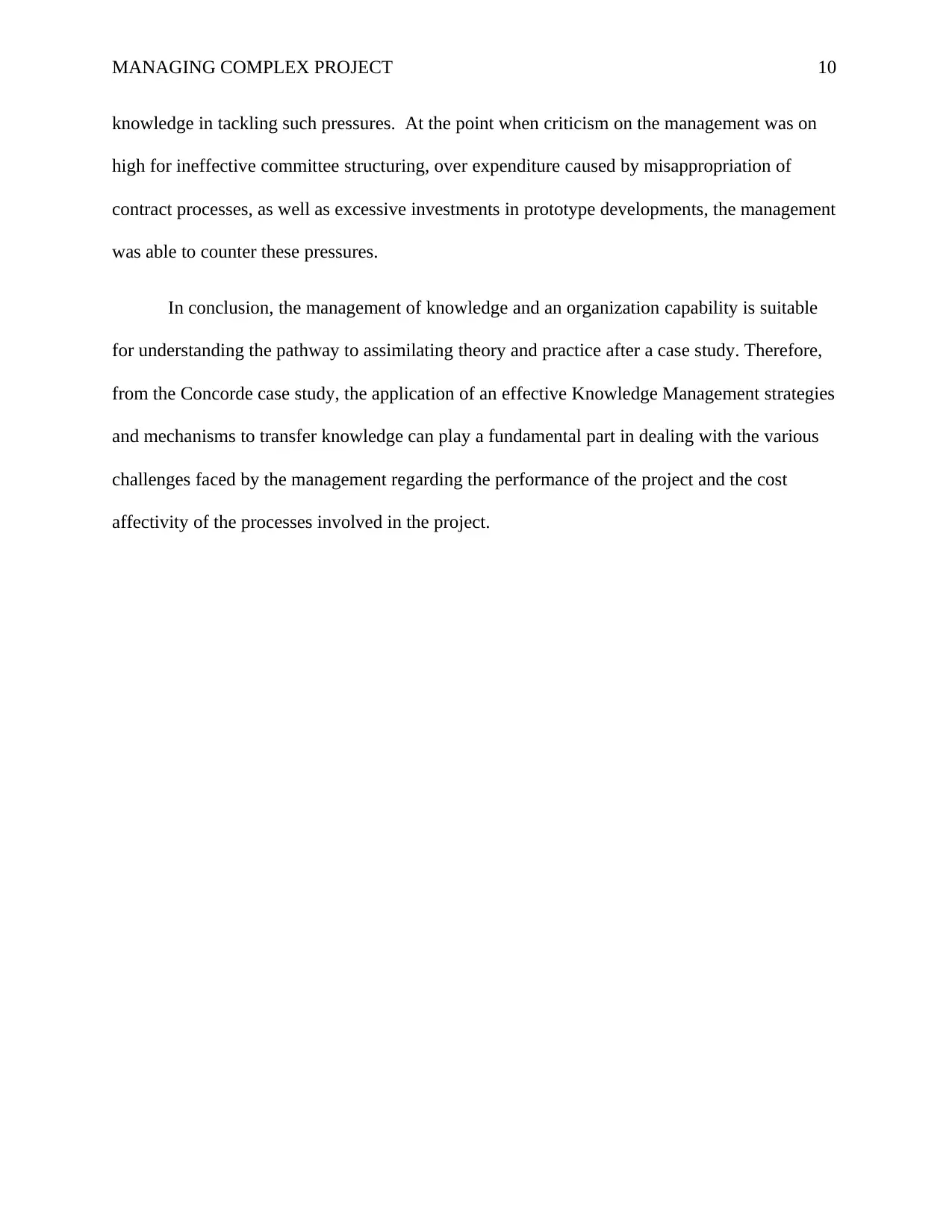
MANAGING COMPLEX PROJECT 10
knowledge in tackling such pressures. At the point when criticism on the management was on
high for ineffective committee structuring, over expenditure caused by misappropriation of
contract processes, as well as excessive investments in prototype developments, the management
was able to counter these pressures.
In conclusion, the management of knowledge and an organization capability is suitable
for understanding the pathway to assimilating theory and practice after a case study. Therefore,
from the Concorde case study, the application of an effective Knowledge Management strategies
and mechanisms to transfer knowledge can play a fundamental part in dealing with the various
challenges faced by the management regarding the performance of the project and the cost
affectivity of the processes involved in the project.
knowledge in tackling such pressures. At the point when criticism on the management was on
high for ineffective committee structuring, over expenditure caused by misappropriation of
contract processes, as well as excessive investments in prototype developments, the management
was able to counter these pressures.
In conclusion, the management of knowledge and an organization capability is suitable
for understanding the pathway to assimilating theory and practice after a case study. Therefore,
from the Concorde case study, the application of an effective Knowledge Management strategies
and mechanisms to transfer knowledge can play a fundamental part in dealing with the various
challenges faced by the management regarding the performance of the project and the cost
affectivity of the processes involved in the project.
Secure Best Marks with AI Grader
Need help grading? Try our AI Grader for instant feedback on your assignments.
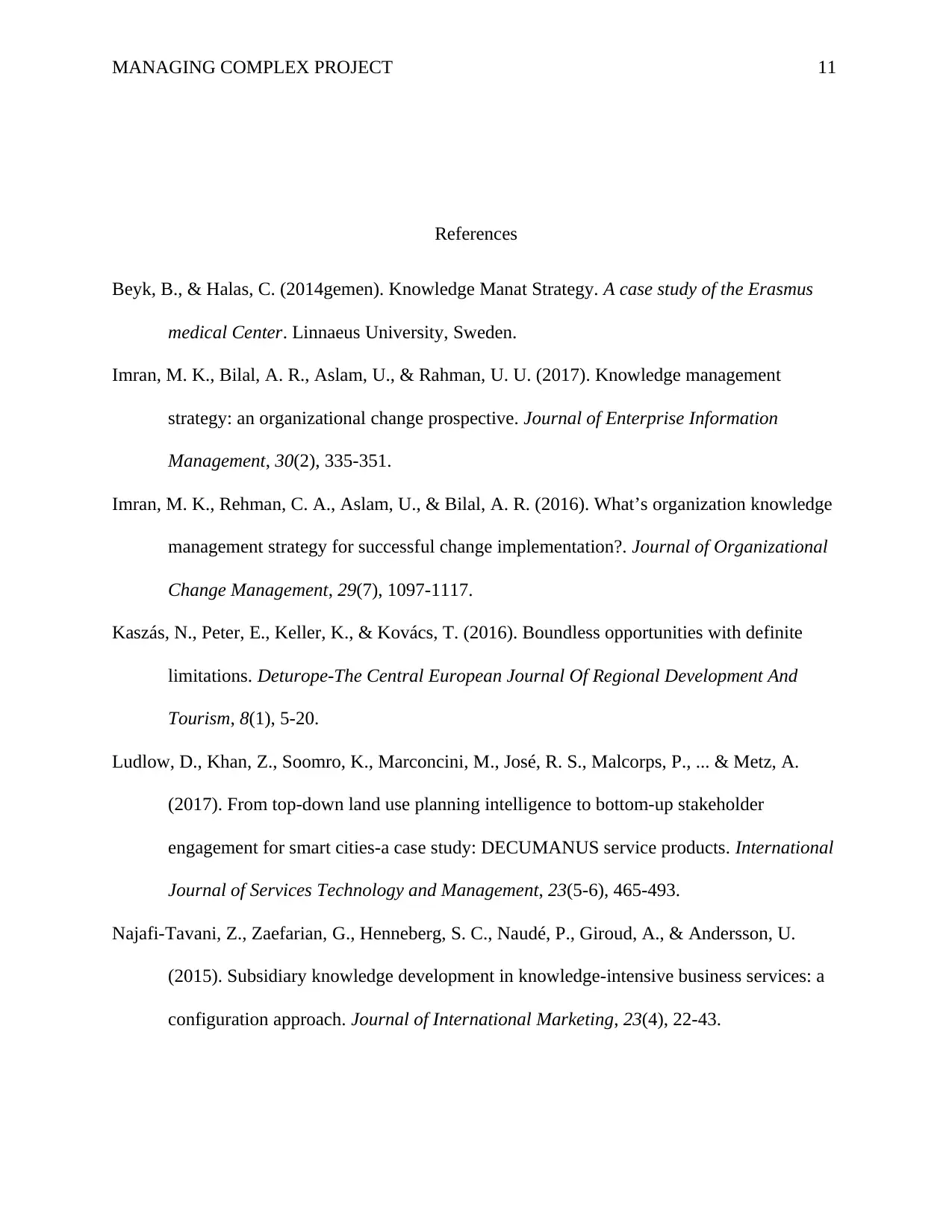
MANAGING COMPLEX PROJECT 11
References
Beyk, B., & Halas, C. (2014gemen). Knowledge Manat Strategy. A case study of the Erasmus
medical Center. Linnaeus University, Sweden.
Imran, M. K., Bilal, A. R., Aslam, U., & Rahman, U. U. (2017). Knowledge management
strategy: an organizational change prospective. Journal of Enterprise Information
Management, 30(2), 335-351.
Imran, M. K., Rehman, C. A., Aslam, U., & Bilal, A. R. (2016). What’s organization knowledge
management strategy for successful change implementation?. Journal of Organizational
Change Management, 29(7), 1097-1117.
Kaszás, N., Peter, E., Keller, K., & Kovács, T. (2016). Boundless opportunities with definite
limitations. Deturope-The Central European Journal Of Regional Development And
Tourism, 8(1), 5-20.
Ludlow, D., Khan, Z., Soomro, K., Marconcini, M., José, R. S., Malcorps, P., ... & Metz, A.
(2017). From top-down land use planning intelligence to bottom-up stakeholder
engagement for smart cities-a case study: DECUMANUS service products. International
Journal of Services Technology and Management, 23(5-6), 465-493.
Najafi-Tavani, Z., Zaefarian, G., Henneberg, S. C., Naudé, P., Giroud, A., & Andersson, U.
(2015). Subsidiary knowledge development in knowledge-intensive business services: a
configuration approach. Journal of International Marketing, 23(4), 22-43.
References
Beyk, B., & Halas, C. (2014gemen). Knowledge Manat Strategy. A case study of the Erasmus
medical Center. Linnaeus University, Sweden.
Imran, M. K., Bilal, A. R., Aslam, U., & Rahman, U. U. (2017). Knowledge management
strategy: an organizational change prospective. Journal of Enterprise Information
Management, 30(2), 335-351.
Imran, M. K., Rehman, C. A., Aslam, U., & Bilal, A. R. (2016). What’s organization knowledge
management strategy for successful change implementation?. Journal of Organizational
Change Management, 29(7), 1097-1117.
Kaszás, N., Peter, E., Keller, K., & Kovács, T. (2016). Boundless opportunities with definite
limitations. Deturope-The Central European Journal Of Regional Development And
Tourism, 8(1), 5-20.
Ludlow, D., Khan, Z., Soomro, K., Marconcini, M., José, R. S., Malcorps, P., ... & Metz, A.
(2017). From top-down land use planning intelligence to bottom-up stakeholder
engagement for smart cities-a case study: DECUMANUS service products. International
Journal of Services Technology and Management, 23(5-6), 465-493.
Najafi-Tavani, Z., Zaefarian, G., Henneberg, S. C., Naudé, P., Giroud, A., & Andersson, U.
(2015). Subsidiary knowledge development in knowledge-intensive business services: a
configuration approach. Journal of International Marketing, 23(4), 22-43.
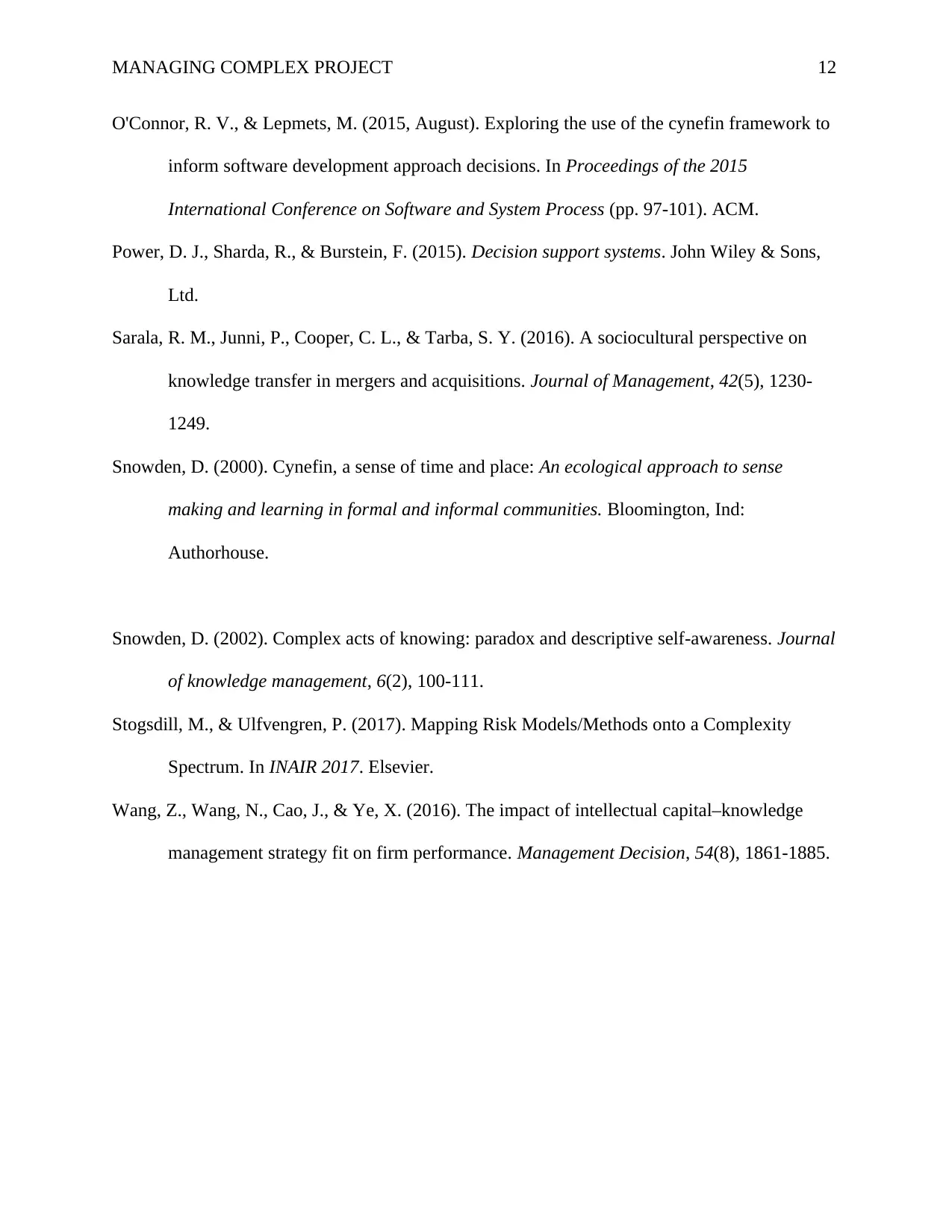
MANAGING COMPLEX PROJECT 12
O'Connor, R. V., & Lepmets, M. (2015, August). Exploring the use of the cynefin framework to
inform software development approach decisions. In Proceedings of the 2015
International Conference on Software and System Process (pp. 97-101). ACM.
Power, D. J., Sharda, R., & Burstein, F. (2015). Decision support systems. John Wiley & Sons,
Ltd.
Sarala, R. M., Junni, P., Cooper, C. L., & Tarba, S. Y. (2016). A sociocultural perspective on
knowledge transfer in mergers and acquisitions. Journal of Management, 42(5), 1230-
1249.
Snowden, D. (2000). Cynefin, a sense of time and place: An ecological approach to sense
making and learning in formal and informal communities. Bloomington, Ind:
Authorhouse.
Snowden, D. (2002). Complex acts of knowing: paradox and descriptive self-awareness. Journal
of knowledge management, 6(2), 100-111.
Stogsdill, M., & Ulfvengren, P. (2017). Mapping Risk Models/Methods onto a Complexity
Spectrum. In INAIR 2017. Elsevier.
Wang, Z., Wang, N., Cao, J., & Ye, X. (2016). The impact of intellectual capital–knowledge
management strategy fit on firm performance. Management Decision, 54(8), 1861-1885.
O'Connor, R. V., & Lepmets, M. (2015, August). Exploring the use of the cynefin framework to
inform software development approach decisions. In Proceedings of the 2015
International Conference on Software and System Process (pp. 97-101). ACM.
Power, D. J., Sharda, R., & Burstein, F. (2015). Decision support systems. John Wiley & Sons,
Ltd.
Sarala, R. M., Junni, P., Cooper, C. L., & Tarba, S. Y. (2016). A sociocultural perspective on
knowledge transfer in mergers and acquisitions. Journal of Management, 42(5), 1230-
1249.
Snowden, D. (2000). Cynefin, a sense of time and place: An ecological approach to sense
making and learning in formal and informal communities. Bloomington, Ind:
Authorhouse.
Snowden, D. (2002). Complex acts of knowing: paradox and descriptive self-awareness. Journal
of knowledge management, 6(2), 100-111.
Stogsdill, M., & Ulfvengren, P. (2017). Mapping Risk Models/Methods onto a Complexity
Spectrum. In INAIR 2017. Elsevier.
Wang, Z., Wang, N., Cao, J., & Ye, X. (2016). The impact of intellectual capital–knowledge
management strategy fit on firm performance. Management Decision, 54(8), 1861-1885.
1 out of 12
Your All-in-One AI-Powered Toolkit for Academic Success.
+13062052269
info@desklib.com
Available 24*7 on WhatsApp / Email
![[object Object]](/_next/static/media/star-bottom.7253800d.svg)
Unlock your academic potential
© 2024 | Zucol Services PVT LTD | All rights reserved.